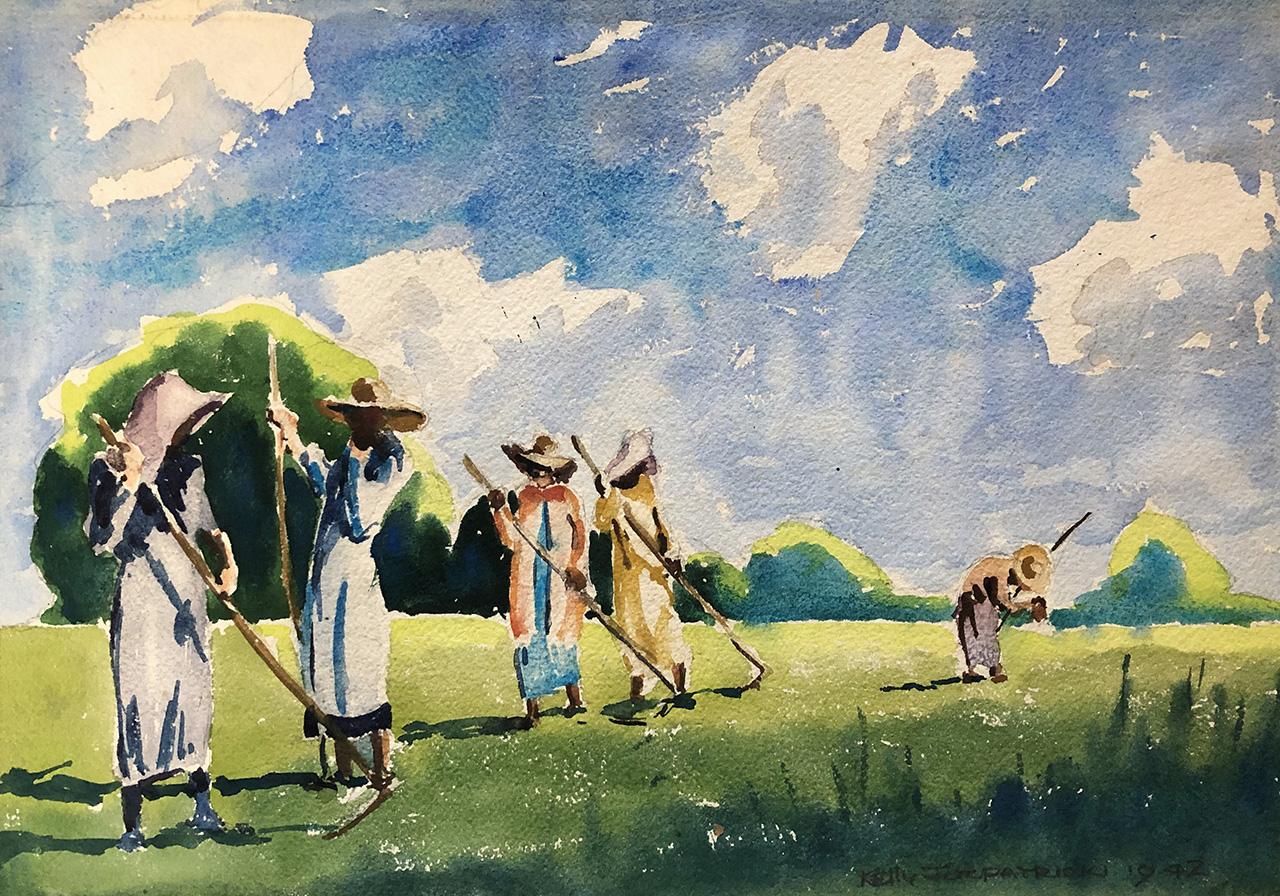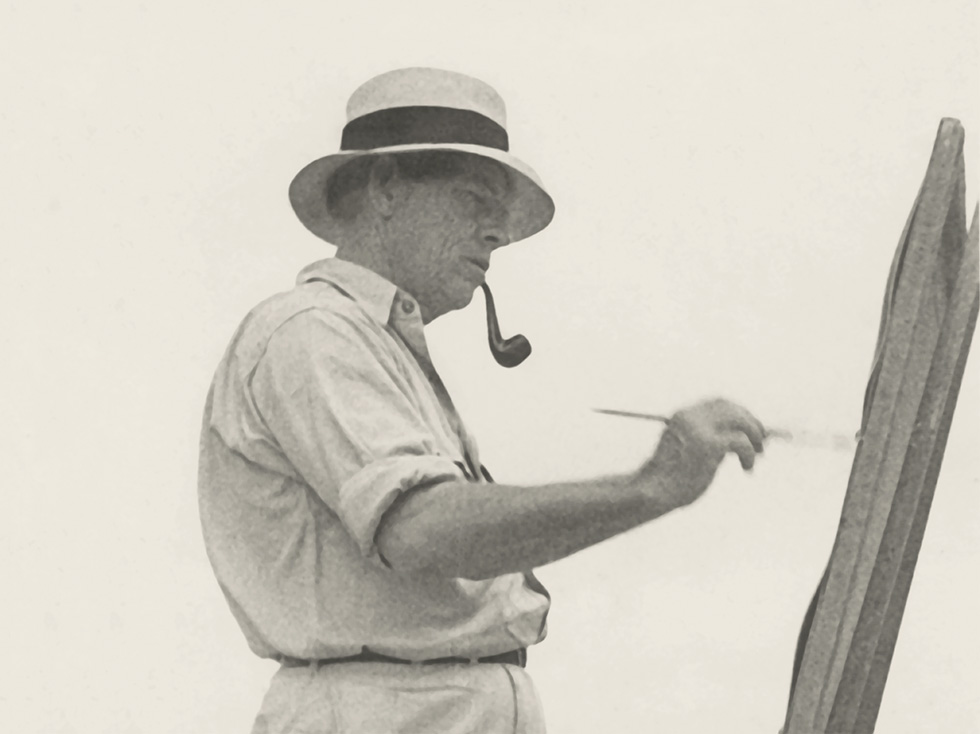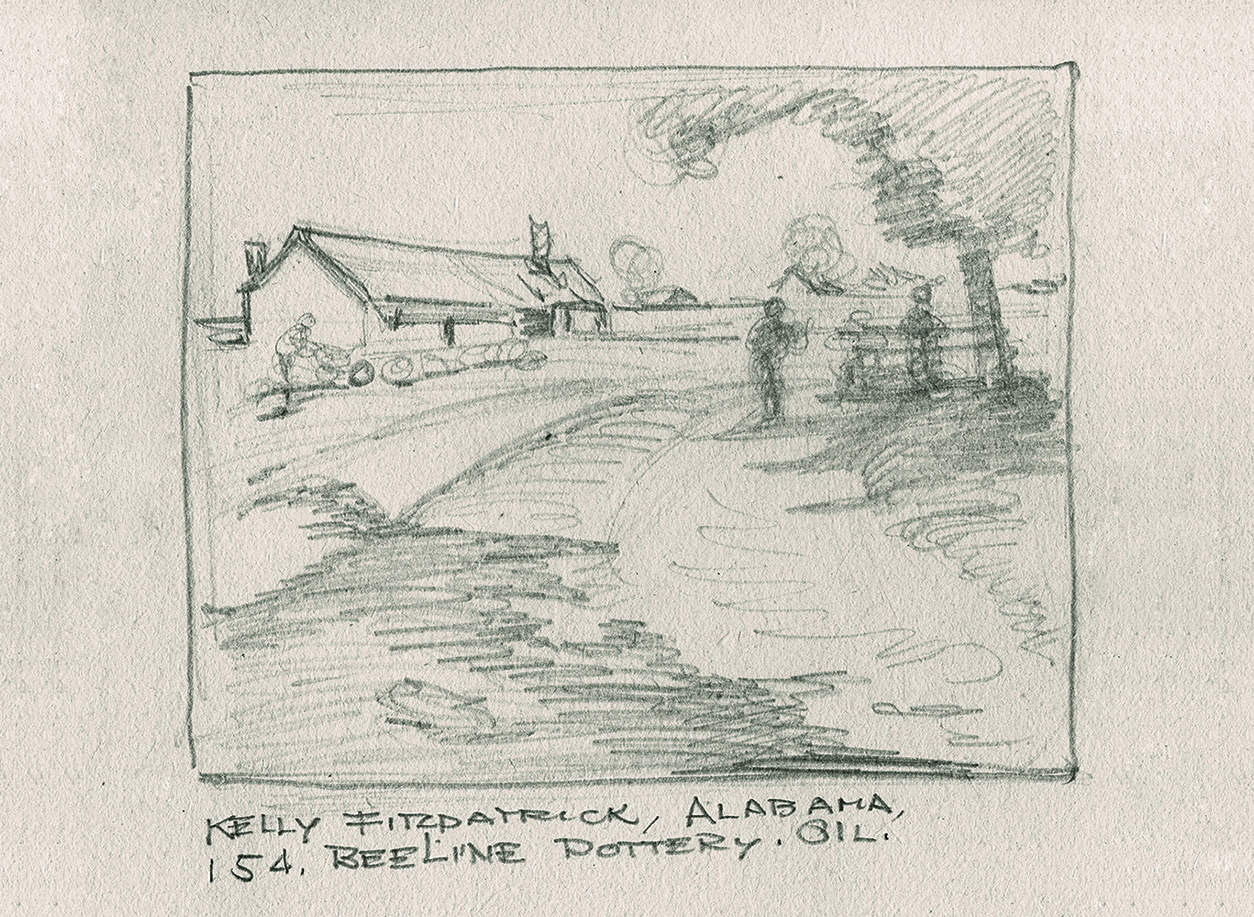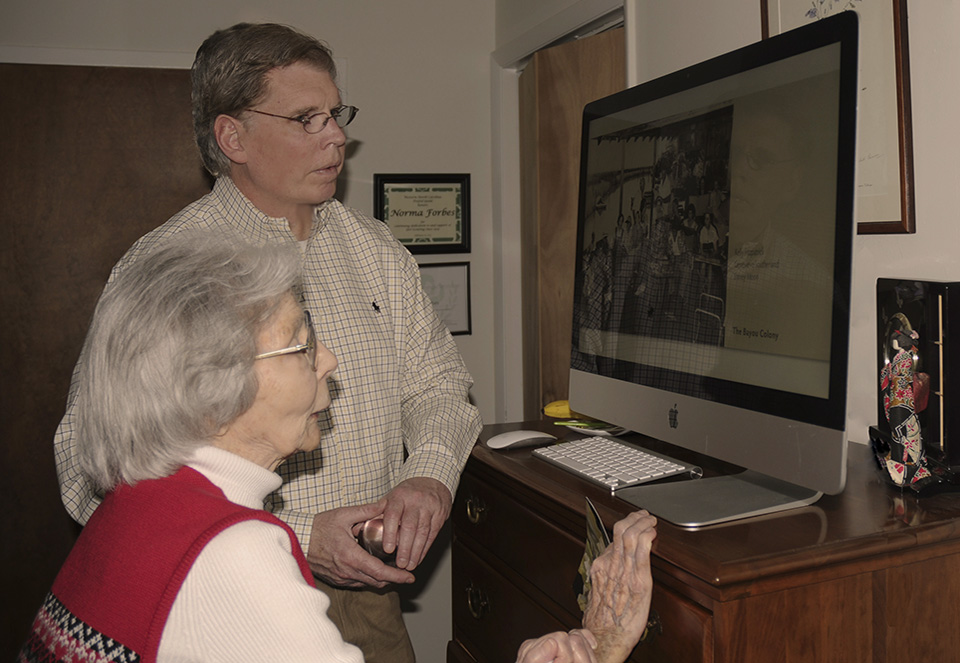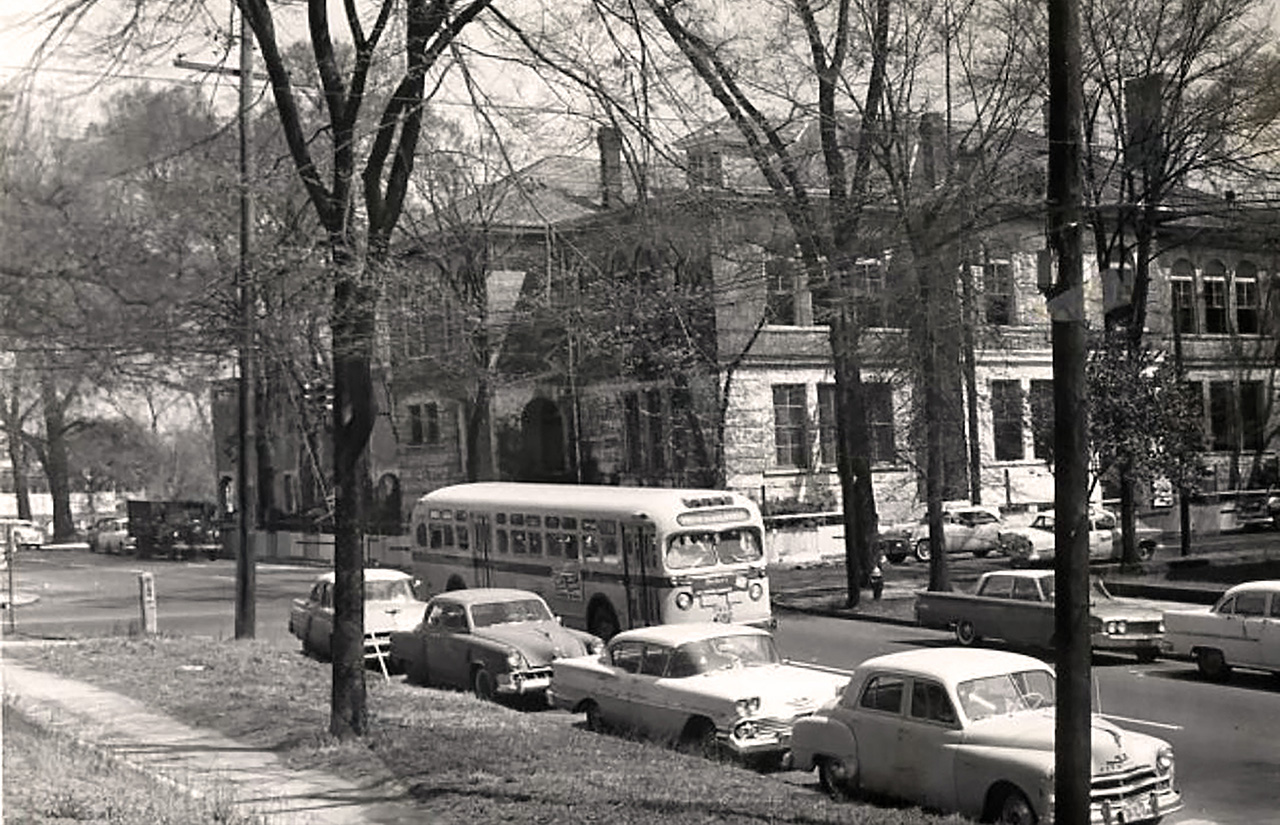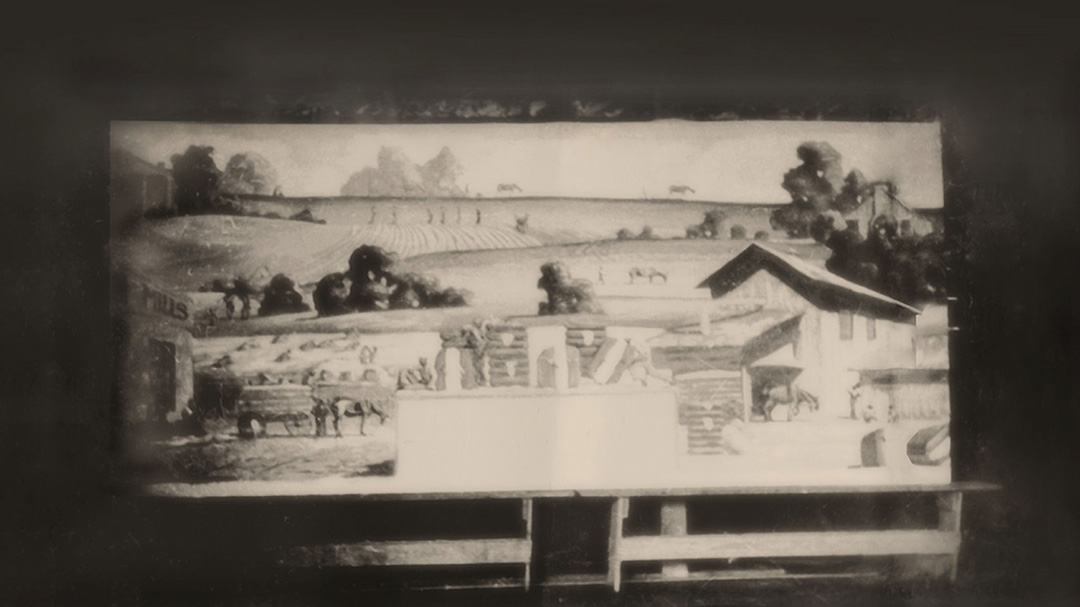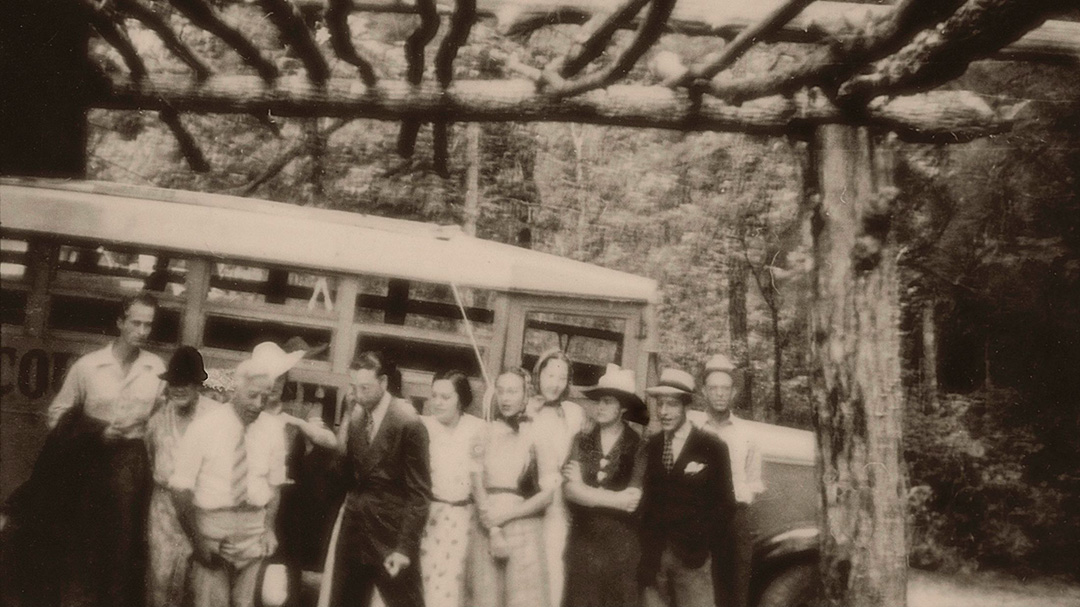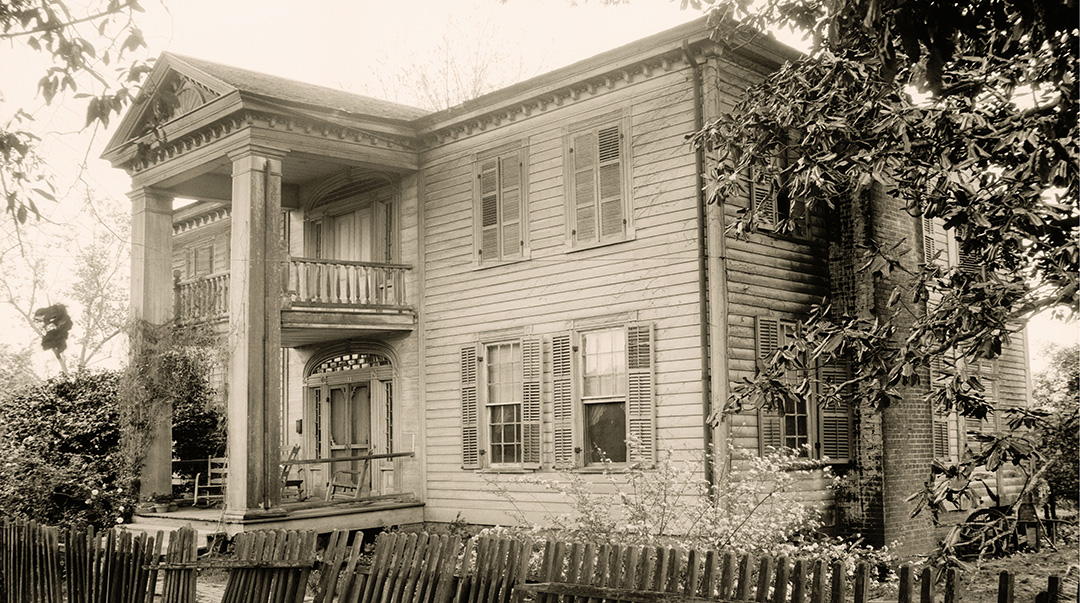–by Mark Andrew Harris, Founder & Director
Due to the outstanding feedback we received from our January 18, 2024, Lunch & Learn program, "All About John Kelly Fitzpatrick: The Story of a Humble Life Well Lived" I thought it appropriate to share some of the information included in the presentation with our followers who were not able to attend our presentation.
JOHN KELLY FITZPATRICK, Elmore County Landscape I, 1942, graphite on paper, 11 x 16.5 inches, JKF-2022.AW.0001 | DAC Foundation Harris Collection
For many years, Kelly Fitzpatrick's birthplace was said to be uncertain and the subject of much debate. I am proud to say that as a result of extensive research, the DAC FOUNDATION located documents that prove that Kelly was, indeed, born in Wetumpka. We uncovered his military records and documents used for his overseas travels, which undisputably document his place of birth. Once we uncovered this information, we worked diligently to get the online information about his place of birth updated with the correct information.
Kelly was born on August 15, 1888, at the Cantelou home at 207 West Tuskeena Street in west Wetumpka. The Cantelous were relatives of the Fitzpatrick family. Their home was just a few blocks from the Fitzpatrick home on Autauga Street. Kelly was the son of Dr. Phillips Fitzpatrick and Jane (Jennie) Lovedy Kelly. Dr. Fitzpatrick's first wife, Mary Ann Bethea, died on March 7, 1879. Together, Fitzpatrick and Bethea bore five children. In 1882, Dr. Fitzpatrick married Jane (Jennie) Lovedy Kelly, and together, they had three children: Aurelia Fitzpatrick, Phil Fitzpatrick, and John Kelly Fitzpatrick. Phil died at age nine, and Aurelia died at age 21.
Benjamin Fitzpatrick and Sarah Terry Elmore were Kelly Fitzpatrick's grandparents. After the death of Sarah Terry Elmore, Benjamin Fitzpatrick married Aurelia Rachel Blassingame, the mother of Benjamin Fitzpatrick of Jasmine Hill Gardens. The elder Benjamin served as Alabama's 11th Governor from 1841 until 1845. He served twice as a U.S. Senator and as President pro tempore of the United States Senate from June 26 until December 2, 1860. He was nominated for Vice President of the United States in 1860 but did not accept the nomination.
JOHN KELLY FITZPATRICK | Source: Dixie Art Art Colony Foundation Archives
Kelly became interested in painting at an early age. In 1904, Kelly told his parents at the World's Fair in St. Louis, MO: "If I could paint a picture good enough to be at a World's Fair, I would be the happiest boy in the world." It took 35 years for Kelly's dream to come true, but it did. In 1939, at the World's Fair in New York, Kelly's painting was included in the fair art exhibition sponsored by IBM. The DAC Foundation is proud to have in its collection the original study sketch for his 1939 entry titled "BeeLine Pottery."
Kelly cultivated that interest during a brief period of study in 1912 at the School of the Art Institute of Chicago. Kelly, also an aspiring writer, studied Journalism at the University of Alabama. The DAC Foundation collection includes a large collection of Kelly's poems and his original manuscript titled "The Crurse of the Jungle Queen." At the age of 37, he studied at the Académie Julian in Paris.
1939 WORLDS FAIR STUDY SKETCH, Beeline Pottery, 1938, graphite on paper, 15.25 x 22.5 inches, JKF-2015.AW.0001 | DAC Foundation Harris Collection
In March of 1918, Fitzpatrick enlisted in the United States Army. He served in the 4th Infantry Division, 8th Infantry Brigade, Company C of the 12th Machine Gun Battalion. On July 19, 1918, Fitzpatrick and his unit came upon a German machine gun nest. During this confrontation, known as the Aisne-Marne Offensive, most of his unit was killed.
Fitzpatrick, one of the few survivors, suffered severe shrapnel wounds to his face, neck, and chest. This offensive, in which 30,000 were killed and wounded, marked the turning of the tide in World War I. After this battle, he received the "Presidential Wound Certificate," what is today the "Purple Heart." Fitzpatrick's war experience changed his entire outlook on life.
JOHN KELLY FITZPATRICK, World War I | Source: Dixie Art Art Colony Foundation Archives
In February 2017, I had the privilege of meeting and spending the day with a close friend of Kelly's named Norma Forbes at her retirement home in Asheville, NC. After lunch, Kim McRae and I sat down with Norma to shoot some video footage of her sharing more of her memories about Kelly Fitzpatrick. She started by sharing stories that Fitzpatrick had shared with her about his experience during World War I and how that intense experience had forever changed the course of his life.
MARK HARRIS AND NORMA FORBES, 2017, Asheville, NC | Source: Dixie Art Art Colony Foundation Archives
Norma stated, "Kelly had gotten a pass to visit Paris but told his friends that he could not go because he didn't have any clean clothes to wear. In turn, his fellow soldiers began to say things like, 'I have a clean shirt you can wear.' 'I have a clean pair of socks you can wear.' I have some clean underwear.' So, through a group effort, his friends put together a clean set of clothes and sent him off to Paris. Of course, he went to the Louvre, where he saw the Mona Lisa. While the museum guide was telling him about the Mona Lisa, Kelly thought to himself, 'Fella, you don't know much about the Mona Lisa; I understand her, and she winked at me as though she approved of what I had said, not of what you said.'"
Norma also told us, "After returning home, Kelly had to make sure that the curtains or blinds on the windows in his bedroom were closed at night. Because if the moonlight suddenly shined brightly through the window, it would startle him so badly that he would start screaming. The flash of light reminded him of the dreaded flash from the large German canon called Big Bertha." Norma continued by explaining Fitzpatrick's newfound philosophy. "After Kelly returned home, he made a vow that from that point forward, he would no longer concern himself with material things, and he was only going to do the things he loved, which were painting and teaching others."
In 1930, artist John Kelly Fitzpatrick, Mrs. Harry S. Houghton (Dorothy Ann Steveson), and the Morning View Painters founded the Montgomery Museum of Fine Arts. The Museum opened in the old Lawrence Street Girls' School building at the corner of Lawrence Street and High Street. The Museum leased the building from the City of Montgomery for an annual rent of one dollar.
In July 1958, construction began on a new facility at the corner of Lawrence Street and McDonough Street. The main floor served as the Montgomery Public Library, and the basement level served as the MMFA. In 1988, the Montgomery Museum of Fine Arts relocated to its current location at Blount Cultural Park.
MONTGOMERY MUSEUM OF FINE ARTS, Lawrence Street Girls’ School building at the corner of Lawrence and High Street | Source: Alabama Department of Archives and History
Just like with the MMFA, the Morning View Painters, and the Montgomery Museum School, it's important to understand that while Kelly was a driving force, he had assistance. Had it not been for the involvement of the Houghton and Carmichael families and the City of Montgomery leadership, none of this would have been possible. The DAC was an arm of the Montgomery Museum School.
Kelly along with several other DAC artists, was an active participant in the WPA Federal Art Projects. He painted numerous easel paintings and two post office murals as part of the program. A significant number of his WPA easel paintings can be found in the collection of the Montgomery Museum of Fine Arts.
DIXIE ART COLONY, Nobles Ferry | Phenix City Post Office, “Early Industry of Dale County” on its way to MMFA | Source: Dixie Art Art Colony Foundation Archives
After Kelly's death on April 18, 1953, his home located at 31 Autauga Street in Wetumpka was torn down due to its dilapidated condition. These are only a few of the many stories to be told about the artist John Kelly Fitzpatrick. For more information about Kelly and the Dixie Art Colony, view our website: DixieArtColony.org or email us at info@DixieArtColony.org.
“Kelly was the life of the colony.... He laughed continually. All he took seriously were art and courtesy—knightly courtesy to people who bored him. Materialism he disdained, responsibility, he’d have nothing of, even refusing to drive a car. He laughed at politics, business status, ambition, ego, pride, vanity... It was impossible not to love him. He made us feel like kids at a circus.” —Karl Ferdinand Wolfe, Jackson MS
Related links: John Kelly Fitzpatrick Bio | Remembering Norma Forbes | Happy Birthday Norma LaMae Forbes
FITZPATRICK HOME, 31 Autauga, Wetumpka, Alabama | Source: The Library of Congress
Sources: Personal interviews, DAC Foundation Archives, Montgomery Advertiser, Birmingham News, The Wetumpka Herald, Alabama Department of Archives and History, Ancestry.com, and the Montgomery Museum of Fine Arts.
The DAC Foundation holds the most extensive Kelly Fitzpatrick and DAC-related ephemera collection of any private or public organization or institution. The DAC collection includes more than 1,600 works of art, representing more than 65 artists.

